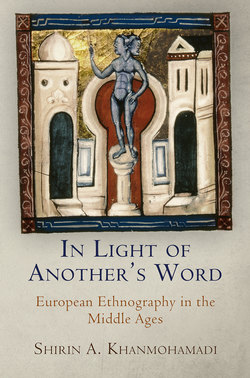In Light of Another's Word

Реклама. ООО «ЛитРес», ИНН: 7719571260.
Оглавление
Shirin A. Khanmohamadi. In Light of Another's Word
Отрывок из книги
In Light of Another’s Word
RUTH MAZO KARRAS, SERIES EDITOR
.....
From this list of monstrous attributes, one might glean what factors compose the “measure of man,” to use John Block Friedman’s phrase,28 and distinguish the human from the monstrous: physical form; modes of diet; dwelling and habitat; sexual, marital, and childbearing practices; clothing; spiritual life; speech; and defense, Pliny suggests, are each constitutive of the “human.” Pliny’s ideas would have reached medieval readers through his ancient encyclopedic abbreviators, Solinus and Isidore of Seville, as well as the thirteenth-century encyclopedist Vincent of Beauvais. Solinus’s Collectanea Rerum Memorabilium cites many of the most popular Plinian races, locating them in the farthest East or in Africa.29 Solinus describes the manners and customs of a number of peoples, including the Arabians, the silk-trading Seres, Indians abstaining from meat, the Tabrobanes and their method of king selection.30 He also offers a long ethnographic excursus on the Scythians, whom he describes in ways that will remind one of Matthew Paris’s Tartars: living in caves, Scythians drink out of the skull cups of their enemies, love fighting, suck the blood out of the wounds they inflict, and, of course, delight in drinking one another’s blood.31 Isidore lists the Plinian races under his consideration of “Portents,” where, he asserts, just as anomalous monstrous births take place among humans, so are there born whole monstrous races, including Cynocephali, Cyclopes, Blemmyas, Antipodes, Pygmies, and so forth.32
Isidore’s and Solinus’s treatment of the Plinian races may well have influenced the classifications of culture that John of Plano Carpini or William of Rubruck employed to describe the foreign Mongols before them, including their dwellings, food, clothing, laws, burial rites, marital rites, and religious beliefs—classifications that reinscribe much the same categories that serve as boundaries between the human and the nonhuman in Pliny, Solinus, and Isidore. But other cultural discourses were also available from which Carpini and Rubruck could derive those categories, including the widespread tradition of that internal other of medieval Europe, the wild man. This tradition was made available by way of the work of the great trio of thirteenth-century encyclopedists, Bartholomew Anglicus, Thomas of Cantimpré, and Vincent of Beauvais, as well as through older textual traditions such as the Alexander saga, the St. Jerome Bible, and the apocryphal Letter of Prester John (c. 1165).33 In a composite sketch of the tradition, an “ethnography of the medieval wild man”34 might look something like the following: the wild man is forest dwelling (thus a literal silvester homo) rather than a city dweller, giant or dwarflike Pygmy in size, hairy, hunting and gathering, eating the raw flesh of animals, without knowledge of agriculture or metallurgy, having great physical strength, warlike, given to sexual carnality, of meager intellect, lacking human speech, incapable of knowing God because irrational, and linked to the semidivine or the semisatanic. Such an ethnography indicates how readily one may treat the discourses of the medieval wild man and the monstrous races as coterminous, invoking as they do many of the same markers for “humanity”—habitat, diet, hunting, sexual practices, speech, religion—and each representing the projection of internal anxieties about the boundaries and norms of “human” behavior on an “other.”
.....